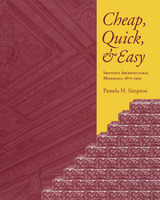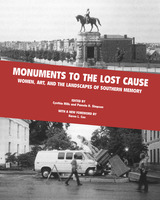2 books about Simpson, Pamela H.

Cheap Quick & Easy
Imitative Architectural Materials
Pamela H. Simpson
University of Tennessee Press, 1999
In this innovative study, Pamela H. Simpson examines the architectural materials that proliferated between 1870 and 1930. Produced by new technology, promoted by new forms of advertising, and eagerly adopted by a new middle class, these “cheap, quick, and easy” materials helped to transform building practices in the United States and Great Britain.
As Simpson shows in fascinating detail, rockface concrete blocks, pressed metal imitations of stone, linoleum “marble” and “parquet,” and embossed wall coverings made available to the masses a host of ornamental effects that only the wealthy could previously have afforded. But, she notes, wherever these new materials appeared, a heated debate over the appropriateness of imitation followed. Were these materials merely tasteless shams? Or were they economical, durable alternatives that democratically extended the possibilities of ornamentation?
Simpson devotes chapters to each of the various ornamental materials, considering its precursors, invention, production, and distribution. In her final chapter, she traces the history of the aesthetic debate over imitation and analyzes the social meaning of the materials. Far from being “bad taste,” she concludes, these new ornamental forms reflected modernism, democracy, and progress—some of the most deeply held values of the period.
The Author: Pamela H. Simpson is Ernest Williams II Professor of Art History at Washington and Lee University. The author of numerous articles and exhibition catalogs, she is co-author (with Royster Lyle) of The Architecture of Historic Lexington. She was president, for the 1997–99 term, of the Vernacular Architecture Forum.
As Simpson shows in fascinating detail, rockface concrete blocks, pressed metal imitations of stone, linoleum “marble” and “parquet,” and embossed wall coverings made available to the masses a host of ornamental effects that only the wealthy could previously have afforded. But, she notes, wherever these new materials appeared, a heated debate over the appropriateness of imitation followed. Were these materials merely tasteless shams? Or were they economical, durable alternatives that democratically extended the possibilities of ornamentation?
Simpson devotes chapters to each of the various ornamental materials, considering its precursors, invention, production, and distribution. In her final chapter, she traces the history of the aesthetic debate over imitation and analyzes the social meaning of the materials. Far from being “bad taste,” she concludes, these new ornamental forms reflected modernism, democracy, and progress—some of the most deeply held values of the period.
The Author: Pamela H. Simpson is Ernest Williams II Professor of Art History at Washington and Lee University. The author of numerous articles and exhibition catalogs, she is co-author (with Royster Lyle) of The Architecture of Historic Lexington. She was president, for the 1997–99 term, of the Vernacular Architecture Forum.
[more]

Monuments to the Lost Cause
Women, Art, And The Landscapes Of Southern Memory
Cynthia Mills
University of Tennessee Press, 2003
This richly illustrated collection of essays, reissued in paperback with a new foreword by Karen L. Cox, examines Confederate memorials from Monument Avenue to Stone Mountain and explores how each monument, with its associated public rituals, testifies to the romanticized narrative of the American Civil War known as the Lost Cause. Several of the fourteen essays highlight the creative leading role played by women’s groups in memorialization, while others explore the alternative ways in which people outside white southern culture wrote their very different histories on the southern landscape. The contributors – who include Karen L. Cox, Richard Guy Wilson, Catherine W. Bishir, W. Fitzhugh Brundage, and William M.S. Ramussen – trace the origins, objectives, and changing consequences of Confederate monuments over time and the dynamics of individuals and organizations that sponsored them. Thus these essays extend the growing literature on the rhetoric of the Lost Cause by shifting the focus to the realm of the visual. They are especially relevant in the present day when Confederate symbols and monuments continue to play a central role in a public – and often emotionally charged – debate about how the South’s past should be remembered.
[more]
READERS
Browse our collection.
PUBLISHERS
See BiblioVault's publisher services.
STUDENT SERVICES
Files for college accessibility offices.
UChicago Accessibility Resources
home | accessibility | search | about | contact us
BiblioVault ® 2001 - 2024
The University of Chicago Press









